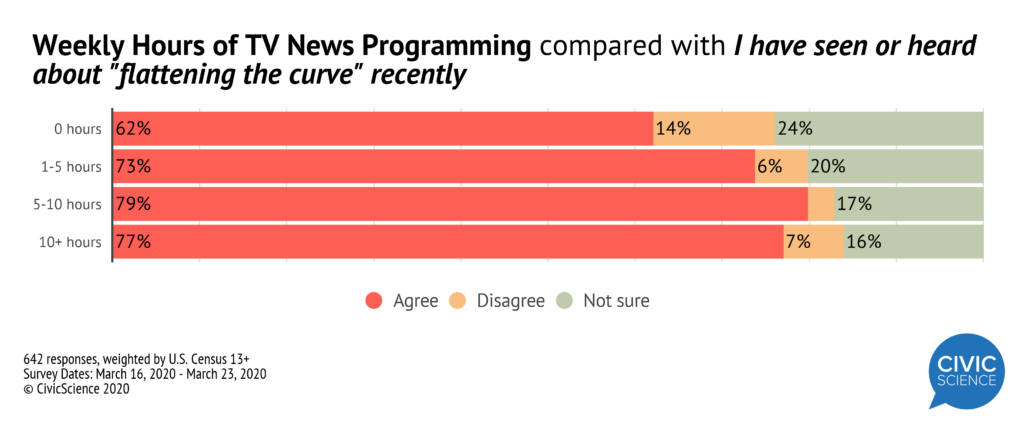One of the biggest catchphrases of the pandemic is “flattening the curve,” that is, slowing the spread of the disease through measures such as social distancing.
CivicScience asked more than 1,800 Americans aged 13 and older about their understanding of the phrase and their trust in its effectiveness. As the data show, 71% of Americans have heard of the terminology. However, that still leaves 30% who have either never heard of the term, or are unsure.
Knowing the language of the pandemic is not necessarily innate. This kind of information must come from somewhere, and for some, it comes from the television.
Tuning in from Where?
Those who are most familiar with the phrase, “flattening the curve” watch television 5 to 10 hours a day. But, chances are it doesn’t take that long to catch on, since 73% of those who only watch 1 to 5 hours have also heard this phrase, and 62% of those who do not watch TV at all are also aware of it.
 That said, the largest percentage of those who have not heard about this terminology do not watch TV at all. This suggests – as earlier reports have noted – that you must be at least somewhat engaged in media to stay current with a pandemic that changes on a moment-to-moment basis.
That said, the largest percentage of those who have not heard about this terminology do not watch TV at all. This suggests – as earlier reports have noted – that you must be at least somewhat engaged in media to stay current with a pandemic that changes on a moment-to-moment basis.
Will Facebook Flatten the Curve?
Of course, television isn’t the only platform for news coverage. Social media has also been a trusted source for some of the population. To gauge awareness, CivicScience compared Facebook, Twitter, and Instagram users with their understanding of the curve concept.
Facebook users are the most aware of the terminology (78%), with Twitter users following close behind (74%). Instagram users, however, lag in awareness. 
Does Awareness Equal Understanding?
As it stands, 70% of Americans also report understanding what flattening the curve means. This suggests that current awareness and understanding are in sync – a fact that is not necessarily given, since awareness and understanding do not necessarily go hand-in-hand. This could indicate that news sources are not just discussing this trend, but also explaining it in a way that makes sense to the public.
Where the discrepancy emerges, however, is in whether or not Americans believe that this concept works. Slightly more than half (56%) agree, leaving more than a third (36%) unsure. 
In this case, confidence in the curve concept boils down to education. Those with a Bachelor’s degree or higher largely agree it works. Those with less education report varying degrees of skepticism and denial. 
And that skepticism may remain for some, at least until more on-the-ground data can confirm whether social distancing, mandated closures and other measures to flatten the curve are making a difference.









